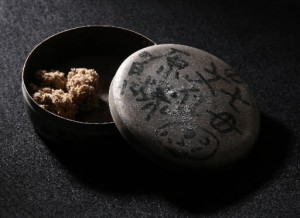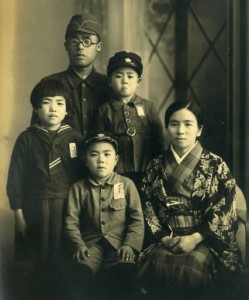Hiroshima: 70 Years After the A-bombing: Words of sorrow on wife’s medicine tin
Jan. 28, 2015
Memento of Toyofumi Ogura, writer of Letters from the End of the World, an A-bomb memoir
Toyofumi Ogura (1899-1996) treasured a medicine tin that his wife, then 37, had on the day of the atomic bombing. Mr. Ogura wrote Zetsugo no Kiroku (Letters from the End of the World) not long after the atomic bombing to preserve his memories, telling the tragedy of Hiroshima and how the metal tin became a memento of his late wife. The tin is now with his eldest daughter and her family, who live in Funabashi City, Chiba Prefecture.
On top of the container are the words, “Fumiyo, our late mother, had this tin on the day of the atomic bombing”; on the bottom, “Inside is medicine for treating chilblains in children during winter”; and on the side, “She was holding this tin at her chest.”
On August 6, 1945, Fumiyo went to buy this medicine to send to her eldest daughter, then 11, who had been evacuated, along with classmates, in the spring to a temple in the northern part of Hiroshima Prefecture. Fumiyo was exposed to the atomic bomb in front of Fukuya Department Store, about 710 meters from the hypocenter.
Zetsugo no Kiroku was published in 1948 and is now reprinted regularly by Chuokoron.
The book explains: “Fumiyo went to a shop near Fukuya Department Store to buy a remedy for chilblains. With the war intensifying, she heard that the shop might close at any time, so she went there to buy some medicine for Kazuko, who was in a village in the mountains, where it would be cold in winter. She thought Kazuko would need it as she always suffered from chilblains.”
Back then, Mr. Ogura was an associate professor at Hiroshima University of Literature and Science (today’s Hiroshima University). In the aftermath of the bombing, he roamed the “scorched city of death” in search of his wife and his second son, Kinji. He found them, but Fumiyo died 13 days after the atomic bombing, leaving behind three children. It took Mr. Ogura a year to write his memoir, in the form of letters to his late wife.
Kazuko Miura, 80, his eldest daughter, showed a picture of her diary dated “August 20” in the English edition of Zetsugo no Kiroku, titled Letters from the End of the World and published in 1997. August 20 was the day she lay beside her dead mother. “I (Kazuko) feel so miserable because I can’t help thinking that I’m responsible for her death. If only I hadn’t had chilblains,” she said, expressing her bitter sorrow.
As her father was originally from Chiba Prefecture, Kazuko became a high school teacher there. Her father later came to live with her, and she looked after him until he died. She is now battling illness of her own.
The medicine tin, the memento of her mother, was discovered within the family’s Buddhist alter by Kazuko’s eldest daughter, Kazue, 49, who is taking care of her. Keiichi, 78, Mr. Ogura’s eldest son and a doctor in the city of Chiba, says this was the first time he, too, saw the container.
Kazue said, “I want to convey my mother’s feelings, too, because she’s been struggling with her trauma over the atomic bombing all her life.” Kazue is now discussing with Keiichi how to preserve and make use of the medicine tin.
(Originally published on January 12, 2015)









